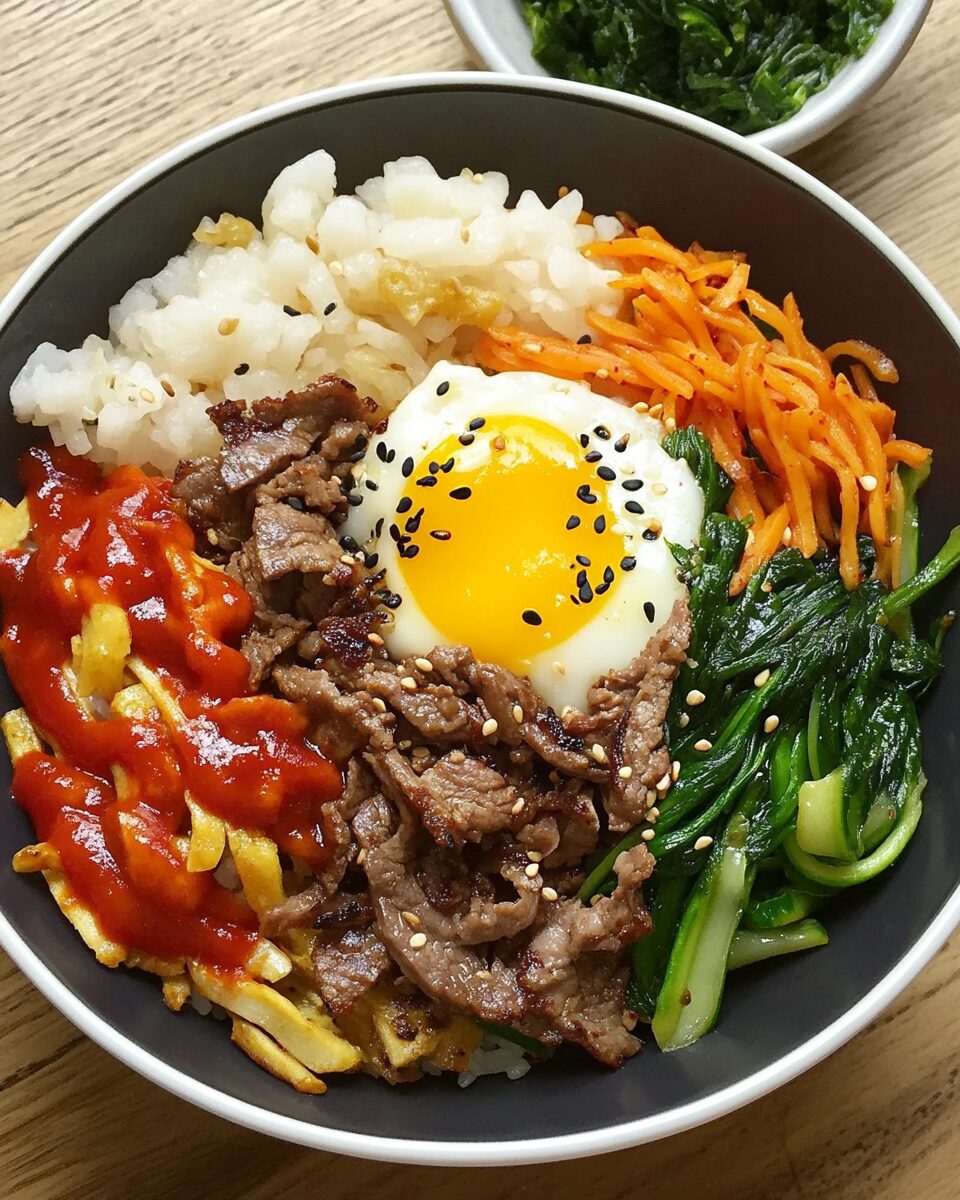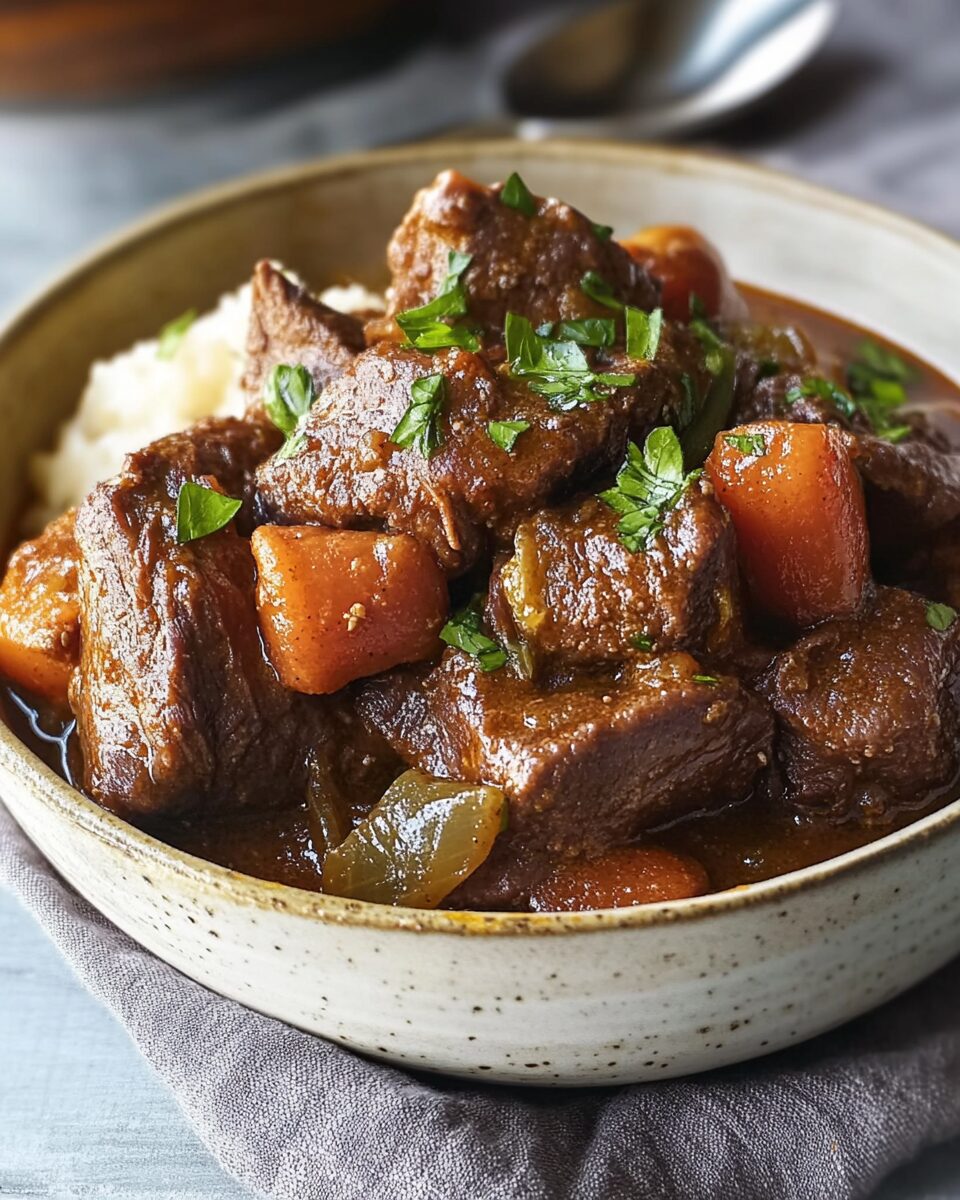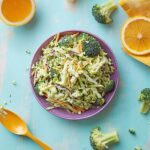Bibimbap is a beautiful and balanced Korean dish that brings together a colorful array of vegetables, savory beef, and a perfectly fried egg, all on a bed of warm rice. The magic of this dish lies in mixing everything together before eating, allowing the spicy gochujang to coat each bite, creating a harmony of flavors and textures that’s both comforting and exciting. This classic meal is perfect for those who enjoy a bit of heat and a variety of fresh ingredients in their diet. Not only is it a feast for the taste buds, but it’s also a visual delight, with each ingredient arranged like a vibrant palette of flavors. Whether you’re enjoying it for lunch or dinner, Bibimbap is sure to become a go-to for a wholesome and satisfying meal that’s as nutritious as it is delicious.
Full recipe:
Ingredients:
- 2 cups cooked white rice
- 1/2 pound ground beef
- 1 tablespoon soy sauce
- 1 tablespoon sesame oil
- 2 garlic cloves, minced
- 1 carrot, julienned
- 1 zucchini, julienned
- 1 cup spinach, blanched
- 1 cup bean sprouts, blanched
- 4 eggs
- 1/2 cup kimchi
- 2 tablespoons gochujang (Korean chili paste)
- Salt and pepper to taste
Directions:
- In a skillet over medium heat, cook the ground beef with soy sauce, sesame oil, and minced garlic until the beef is browned. Season with salt and pepper to taste.
- In separate pans, lightly sauté the carrot and zucchini with a pinch of salt until tender but still crisp.
- Blanch the spinach and bean sprouts in boiling water for about 1-2 minutes. Drain well and season with a bit of salt.
- Fry each egg sunny-side up.
- To assemble, place a portion of cooked rice into each bowl. Arrange the cooked beef, carrots, zucchini, spinach, bean sprouts, and kimchi in sections around the rice.
- Add a spoonful of gochujang on top and place a fried egg over each serving.
- Mix everything together before eating, adjusting the amount of gochujang according to your preference.
Prep Time: 15 minutes | Cooking Time: 20 minutes | Total Time: 35 minutes
Kcal: 500 kcal | Servings: 4 servings
The Origins of Bibimbap
Bibimbap’s origins are believed to date back to the Joseon Dynasty (1392–1910). In Korean culture, it was often prepared and eaten during certain holidays or celebrations. For example, it was traditionally served during the Lunar New Year to use up all the leftover side dishes before the next round of freshly prepared food. The dish’s assembly, with its colorful arrangement of vegetables, meats, and rice, symbolizes harmony and unity—a representation of Korea’s value on balance and community.
Another cultural note: bibimbap was also considered a practical meal for farmers and travelers. Back in the day, people working in the fields or traveling long distances would pack the various components in bowls and mix them just before eating, making it a convenient yet nourishing meal on the go.
Nutritional Benefits of Bibimbap
Bibimbap is much more than just a treat for your taste buds; it’s a nutritional powerhouse. The variety of ingredients offers a balance of protein, complex carbohydrates, healthy fats, and fiber. Here are some of the key health benefits of bibimbap:
- Rich in Protein: The dish often features ground beef, chicken, or even tofu, providing a solid dose of protein, which is essential for muscle repair, growth, and overall energy. The fried egg on top adds another layer of protein and healthy fats.
- Nutrient-Dense Vegetables: Bibimbap is filled with a colorful array of vegetables like spinach, carrots, zucchini, and bean sprouts, all of which are packed with vitamins and minerals. For instance, spinach is high in iron, while carrots are rich in beta-carotene, an antioxidant that is great for skin and eye health.
- Low in Calories: While bibimbap is rich in flavor, it is relatively low in calories compared to many other rice-based dishes. With controlled portions of meat and vegetables, it can easily fit into a balanced diet, providing a filling meal without excessive caloric intake.
- Gochujang for a Metabolism Boost: One of the key elements of bibimbap is gochujang, a Korean chili paste made from fermented soybeans, rice, and red chili powder. Gochujang not only adds a kick of spice but is also rich in capsaicin, a compound that has been shown to boost metabolism and help with weight management.
- Probiotics from Kimchi: Many people enjoy their bibimbap with a side of kimchi, a traditional fermented vegetable dish. Kimchi is packed with probiotics, which are beneficial for digestive health and can help improve gut flora.
Why This Bibimbap Recipe is a Must-Try
This particular bibimbap recipe strikes the perfect balance between tradition and accessibility. It stays true to classic Korean flavors while being simple enough for beginners to try at home. Here’s why this recipe is a great addition to your culinary repertoire:
- Customizable and Versatile: One of the best things about bibimbap is its versatility. You can adapt it to suit your dietary needs or personal preferences. Not a fan of beef? Swap it for chicken, tofu, or even mushrooms for a plant-based version. You can also adjust the spice level by adding more or less gochujang, making it as mild or fiery as you like.
- Aesthetic Appeal: The visual presentation of bibimbap is a feast for the eyes. The vibrant colors of the carrots, spinach, zucchini, and sunny-side-up egg create a stunning visual contrast that can make any dinner table feel special. It’s a fantastic dish to serve when you have guests over and want to impress them with a meal that looks as good as it tastes.
- Quick to Prepare: Despite its sophisticated look, this recipe is surprisingly quick to prepare. The steps are straightforward, and you can prepare the vegetables and beef while the rice is cooking. It’s ideal for a weeknight dinner when you want something hearty but don’t have much time to spend in the kitchen.
- Balanced and Wholesome: With a balance of protein, carbohydrates, and healthy fats, this bibimbap recipe can serve as a complete meal in a single bowl. This makes it a great option for those looking for a nutritious and balanced diet, whether you’re focused on weight loss, muscle gain, or simply maintaining a healthy lifestyle.
- Cultural Connection: Cooking and enjoying bibimbap at home can be a wonderful way to connect with Korean culture. It provides a small window into the rich culinary traditions of Korea, offering a sense of appreciation for the country’s emphasis on harmony, balance, and the celebration of seasonal ingredients.
Tips for the Perfect Bibimbap
To make sure your bibimbap comes out perfect every time, here are a few tips:
- Use Day-Old Rice: If possible, use rice that has been cooked the day before. Day-old rice has a firmer texture, making it ideal for dishes like bibimbap, where you want the grains to stay separate and not become too mushy.
- Blanch and Squeeze the Vegetables: When preparing the spinach and bean sprouts, it’s important to blanch them briefly and then squeeze out the excess water. This keeps them tender while maintaining their texture and prevents them from becoming soggy when mixed with the rice.
- Adjust the Gochujang to Your Liking: Gochujang can be quite spicy, so start with a small amount if you’re new to it, and gradually add more according to your taste. You can also dilute it with a bit of sesame oil or water if you prefer a milder heat.
- Mix Just Before Eating: The magic of bibimbap happens when you mix everything together just before eating. This allows the gochujang to coat the ingredients evenly and combines the flavors into a delicious, cohesive bite.
Serving and Pairing Suggestions
Bibimbap is best served in a hot stone bowl (known as dolsot), which helps to keep the rice warm and creates a crispy layer at the bottom that adds an extra textural element to the dish. However, if you don’t have a stone bowl, any large serving bowl will do. For an authentic Korean dining experience, you can serve it alongside banchan, which are small side dishes such as kimchi, pickled radishes, and seasoned seaweed.
To complement the rich and spicy flavors of bibimbap, you might also consider serving it with a light soup like doenjang-jjigae (soybean paste stew) or miso soup. The warm, umami-rich broth pairs beautifully with the bold flavors of the bibimbap.
Conclusion
Bibimbap is a testament to the beauty of simplicity and balance in Korean cooking. It’s a dish that anyone can enjoy, regardless of their familiarity with Korean cuisine. The best part is that it’s not just a meal; it’s an experience mixing everything together, tasting the unique combination of flavors in each bite, and appreciating the way the ingredients come together to create something truly greater than the sum of its parts.
Whether you’re a seasoned cook or just starting your culinary journey, this bibimbap recipe offers a chance to explore new flavors and learn more about the art of Korean cooking. It’s the perfect way to bring a taste of Korea into your home and share a bit of its rich culinary tradition with your loved ones.








